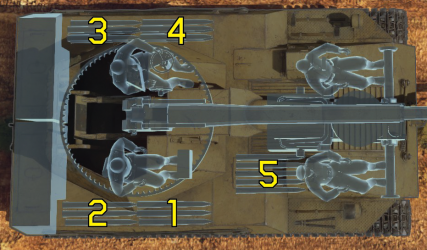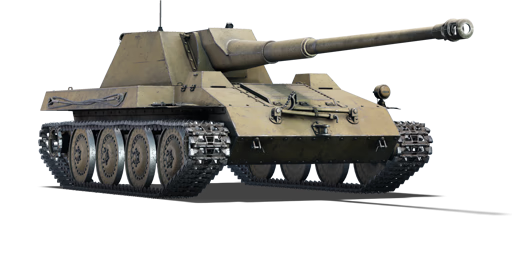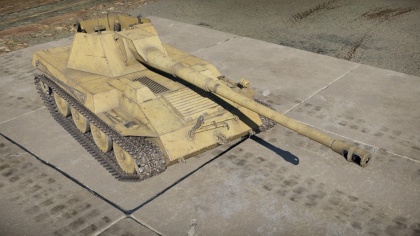Difference between revisions of "Waffentrager"
FADESHADOW (talk | contribs) (→Usage in the battles) (Tag: Visual edit) |
(Edits.) |
||
| Line 186: | Line 186: | ||
== Usage in the battles == | == Usage in the battles == | ||
| − | Best way to use this tank is to stay hidden and keep your distance,only expose yourself when you want to shoot and try to stay unnoticed as much as possible. This tank doesn't have any | + | <!--''Describe the tactics of playing in the vehicle, the features of using vehicles in the team and advice on tactics. Refrain from creating a "guide" - do not impose a single point of view but give the reader food for thought. Describe the most dangerous enemies and give recommendations on fighting them. If necessary, note the specifics of the game in different modes (AB, RB, SB).''--> |
| + | Best way to use this tank is to stay hidden and keep your distance, only expose yourself when you want to shoot and try to stay unnoticed as much as possible. This tank doesn't have any machine guns coverage, so always try to one shot the SPAAGs otherwise you will become an easy target. | ||
=== Pros and cons === | === Pros and cons === | ||
| Line 197: | Line 198: | ||
* Low profile construction makes the vehicle easily conceal | * Low profile construction makes the vehicle easily conceal | ||
* Suspension and tracks cover a good portion of the lower side hull for protection | * Suspension and tracks cover a good portion of the lower side hull for protection | ||
| − | * All AP and APHE shells | + | * All AP and APHE shells over-pierce the tank without dealing much damage due to the very thin armour |
'''Cons:''' | '''Cons:''' | ||
| − | * Open-top turret crew vulnerable to | + | * Open-top turret crew vulnerable to shrapnel, machine guns, air strikes, artillery, and such |
* Gun recoil can jump the vehicle dramatically, throwing off the aim and bouncing the vehicle position | * Gun recoil can jump the vehicle dramatically, throwing off the aim and bouncing the vehicle position | ||
* Very thin overall armour of between 10-20 mm | * Very thin overall armour of between 10-20 mm | ||
| − | * 5 mm roof armour means aerial attack | + | * 5 mm roof armour means an aerial attack is deadly |
* 5 mm belly armour makes any HE shots able to penetrate through the bottom | * 5 mm belly armour makes any HE shots able to penetrate through the bottom | ||
* Front-mounted engine and transmission means both can be knocked out with a front shot, immobilizing the vehicle | * Front-mounted engine and transmission means both can be knocked out with a front shot, immobilizing the vehicle | ||
| Line 212: | Line 213: | ||
<!--''Describe the history of the creation and combat usage of the ground vehicle in more detail than in the introduction. If the historical reference turns out to be too big, take it to a separate article, taking a link to an article about the vehicle and adding a block "/historical reference" (example: https://wiki.warthunder.com/Name-vehicles/historical reference) and add a link to it here using the <code>main</code> template. Be sure to include links to sources at the end of the article.''--> | <!--''Describe the history of the creation and combat usage of the ground vehicle in more detail than in the introduction. If the historical reference turns out to be too big, take it to a separate article, taking a link to an article about the vehicle and adding a block "/historical reference" (example: https://wiki.warthunder.com/Name-vehicles/historical reference) and add a link to it here using the <code>main</code> template. Be sure to include links to sources at the end of the article.''--> | ||
===Development=== | ===Development=== | ||
| − | In as early as 1942, the German Wehrmacht was looking for a way to make large anti-tank guns easier to deploy and transport, but also should be able to fire the gun and fight on the front lines. Four major German companies (Krupp, Rheinmetall, Borsig, and Ardelt) took part in a tender of the Waffenamt (German Army Weapons Agency) in 1943 for the project. Then, in April 1944, the four companies presented their prototypes. With Krupp and Steyr working together on a design, and Rheinmetall and Borsig on their own. Both designs envisaged placing the 8.8 cm PaK 43 L / 71 in a | + | In as early as 1942, the German Wehrmacht was looking for a way to make large anti-tank guns easier to deploy and transport, but also should be able to fire the gun and fight on the front lines. Four major German companies (Krupp, Rheinmetall, Borsig, and Ardelt) took part in a tender of the Waffenamt (German Army Weapons Agency) in 1943 for the project. Then, in April 1944, the four companies presented their prototypes. With Krupp and Steyr working together on a design, and Rheinmetall and Borsig on their own. Both designs envisaged placing the 8.8 cm PaK 43 L / 71 in a lightly armoured, upwardly open, rotatable tower mounted on a hull of a Raupenschlepper Ost (a tracked artillery mover) to keep costs down and reduce complexity. However, the decision was made for the prototype of the last company, Ardelt, therefore making the Krupp-Steyr design unwanted by the Waffenamt. |
===Combat usage=== | ===Combat usage=== | ||
Revision as of 16:19, 30 March 2019
Contents
Description
The Waffenträger Krupp-Steyr mit Pak 43 is a Rank III German tank destroyer
with a battle rating of 5.7 (AB/RB/SB). It was introduced in Update 1.71 "New E.R.A".
General info
Survivability and armour
Armour type:
- Rolled homogeneous armour
| Armour | Front (Slope angle) | Sides | Rear | Roof |
|---|---|---|---|---|
| Hull | 10 mm (76°), 20 mm (46°) Front glacis 5 mm (46°) Engine grille 20 mm (44°) Lower glacis 10 mm (46°) Crew ports |
10 mm (25°) Top 10 mm Bottom |
10 mm (26°) Top 10 mm (15°) Bottom |
5 mm |
| Turret | 20 mm (41°) Turret front 20 mm (5-46°) Gun mantlet |
10 mm (22-24°) | 10 mm (24°) | N/A |
Notes:
- Suspension wheels are 20 mm thick and tracks are 30 mm thick.
- Belly armour is 5 mm thick.
- A 10 mm structural steel plate covers the engine from the crew.
Mobility
| Mobility characteristic | ||
|---|---|---|
| Weight (tons) | Add-on Armor weight (tons) |
Max speed (km/h) |
| 16.3 | N/A | 38 (AB) |
| 35 (RB/SB) | ||
| Engine power (horsepower) | ||
| Mode | Stock | Upgraded |
| Arcade | 199 | ___ |
| Realistic/Simulator | 124 | ___ |
| Power-to-weight ratio (hp/ton) | ||
| Mode | Stock | Upgraded |
| Arcade | 12.21 | __.__ |
| Realistic/Simulator | 7.61 | __.__ |
Armaments
Main armament
| 88 mm PaK 43 | |||||
|---|---|---|---|---|---|
| Capacity | Vertical guidance |
Horizontal guidance |
Stabilizer | ||
| 30 | -8°/+45° | ±180° | N/A | ||
| Turret rotation speed (°/s) | |||||
| Mode | Stock | Upgraded | Prior + Full crew | Prior + Expert qualif. | Prior + Ace qualif. |
| Arcade | 12.33 | 17.06 | __.__ | __.__ | 24.38 |
| Realistic | 8.33 | 9.80 | __.__ | __.__ | 14.00 |
| Reloading rate (seconds) | |||||
| Stock | Prior + Full crew | Prior + Expert qualif. | Prior + Ace qualif. | ||
| 11.05 | __.__ | __.__ | 8.50 | ||
Ammunition
| Penetration statistics | |||||||
|---|---|---|---|---|---|---|---|
| Ammunition | Type of warhead |
Penetration in mm @ 90° | |||||
| 10m | 100m | 500m | 1000m | 1500m | 2000m | ||
| PzGr 39/43 | APCBC | 236 | 234 | 221 | 207 | 193 | 180 |
| Sprgr. L/4,5 | HE | 13 | 13 | 12 | 11 | 11 | 11 |
| Hl.Gr 39 | HEAT | 110 | 110 | 110 | 110 | 110 | 110 |
| PzGr 40/43 | APCR | 272 | 270 | 250 | 228 | 208 | 189 |
| Shell details | ||||||||||
|---|---|---|---|---|---|---|---|---|---|---|
| Ammunition | Type of warhead |
Velocity in m/s |
Projectile Mass in kg |
Fuse delay
in m: |
Fuse sensitivity
in mm: |
Explosive Mass in g (TNT equivalent): |
Normalization At 30° from horizontal: |
Ricochet: | ||
| 0% | 50% | 100% | ||||||||
| PzGr 39/43 | APCBC | 1000 | 10.16 | 0.8 | 28 | 108.8 | +4° | 48° | 63° | 71° |
| Sprgr. L/4,5 | HE | 820 | 9 | 0.1 | 0.5 | 698 | +0° | 79° | 80° | 81° |
| Hl.Gr 39 | HEAT | 600 | 7.64 | 0.0 | 0.3 | 1,100 | +0° | 62° | 69° | 73° |
| PzGr 40/43 | APCR | 1,130 | 7.3 | N/A | N/A | N/A | +1.5° | 66° | 70° | 72° |
Ammo racks

| Full ammo |
1st rack empty |
2nd rack empty |
3rd rack empty |
4th rack empty |
5th rack empty |
Recommendations | Visual discrepancy |
|---|---|---|---|---|---|---|---|
| 30 | 26 (+4) | 21 (+9) | 16 (+14) | 11 (+19) | 1 (+29) | Right side empty: 21 (+9) | No |
Usage in the battles
Best way to use this tank is to stay hidden and keep your distance, only expose yourself when you want to shoot and try to stay unnoticed as much as possible. This tank doesn't have any machine guns coverage, so always try to one shot the SPAAGs otherwise you will become an easy target.
Pros and cons
Pros:
- 88 mm Pak 43 gun power can destroy any vehicle it meets
- Full rotating turret with the powerful gun
- Decent -8° gun depression for hull-down positions
- Low profile construction makes the vehicle easily conceal
- Suspension and tracks cover a good portion of the lower side hull for protection
- All AP and APHE shells over-pierce the tank without dealing much damage due to the very thin armour
Cons:
- Open-top turret crew vulnerable to shrapnel, machine guns, air strikes, artillery, and such
- Gun recoil can jump the vehicle dramatically, throwing off the aim and bouncing the vehicle position
- Very thin overall armour of between 10-20 mm
- 5 mm roof armour means an aerial attack is deadly
- 5 mm belly armour makes any HE shots able to penetrate through the bottom
- Front-mounted engine and transmission means both can be knocked out with a front shot, immobilizing the vehicle
- Poor acceleration
History
Development
In as early as 1942, the German Wehrmacht was looking for a way to make large anti-tank guns easier to deploy and transport, but also should be able to fire the gun and fight on the front lines. Four major German companies (Krupp, Rheinmetall, Borsig, and Ardelt) took part in a tender of the Waffenamt (German Army Weapons Agency) in 1943 for the project. Then, in April 1944, the four companies presented their prototypes. With Krupp and Steyr working together on a design, and Rheinmetall and Borsig on their own. Both designs envisaged placing the 8.8 cm PaK 43 L / 71 in a lightly armoured, upwardly open, rotatable tower mounted on a hull of a Raupenschlepper Ost (a tracked artillery mover) to keep costs down and reduce complexity. However, the decision was made for the prototype of the last company, Ardelt, therefore making the Krupp-Steyr design unwanted by the Waffenamt.
Combat usage
Due to the design losing the tender, the tank never saw mass production or combat service. Only one wooden model and one prototype were manufactured on September 2, 1944.
Media
An excellent addition to the article will be video guides, as well as screenshots from the game and photos.
Read also
Links to the articles on the War Thunder Wiki that you think will be useful for the reader, for example,
- reference to the series of the vehicles;
- links to approximate analogues of other nations and research trees.
ETC.
Sources
| Germany tank destroyers | |
|---|---|
| Pz. I Derivatives | Panzerjäger I |
| Pz. II Derivatives | 15cm sIG 33 B Sfl |
| Pz. 38(t) Derivatives | Marder III · Marder III H · Jagdpanzer 38(t) |
| Pz. III Derivatives | StuG III A · StuG III F · StuG III G · StuH 42 G |
| Pz. IV Derivatives | Jagdpanzer IV · Panzer IV/70(A) · Panzer IV/70(V) · Dicker Max · Nashorn · Brummbär · VFW |
| Pz. V Derivatives | Jagdpanther G1 · Bfw. Jagdpanther G1 |
| Pz. VI Derivatives | Sturer Emil · Elefant · Ferdinand · 38 cm Sturmmörser · Jagdtiger |
| Wheeled/Half-track | 8,8 cm Flak 37 Sfl. · Sd.Kfz.251/9 · Sd.Kfz.251/10 · Sd.Kfz.251/22 · Sd.Kfz.234/3 · Sd.Kfz.234/4 · 15 cm Pz.W.42 |
| ATGM Carrier | RakJPz 2 · RakJPz 2 (HOT) · Wiesel 1A2 |
| Other | Waffenträger · M109G · JPz 4-5 · Raketenautomat · VT1-2 |





